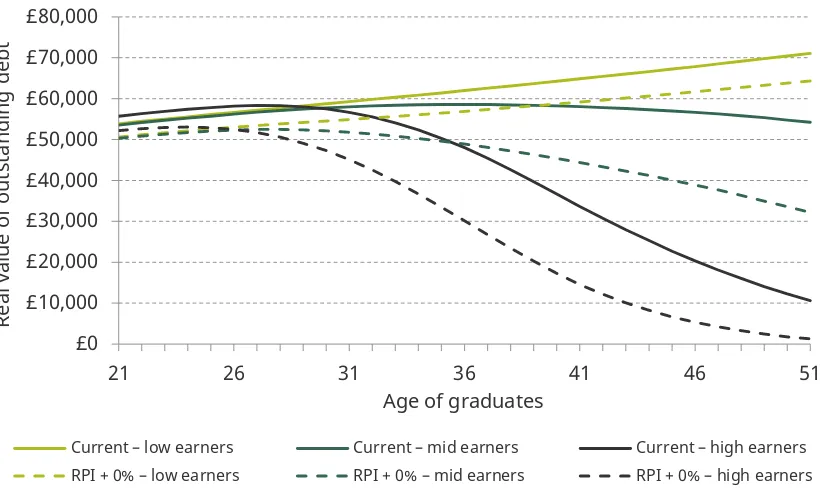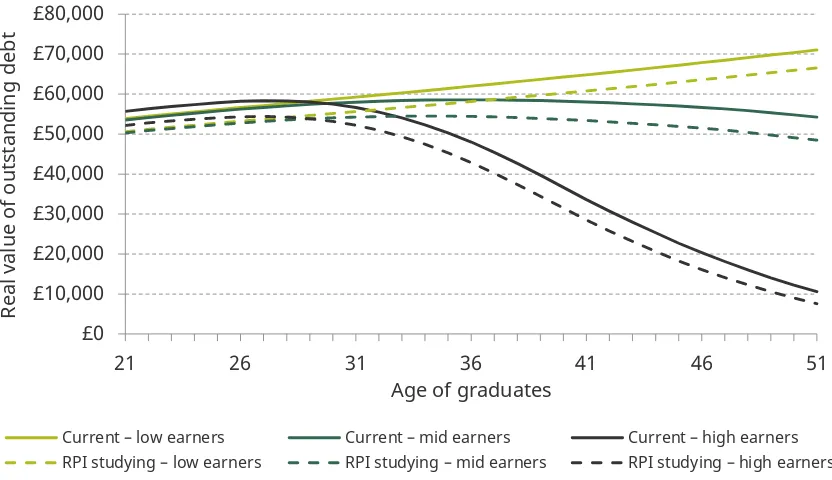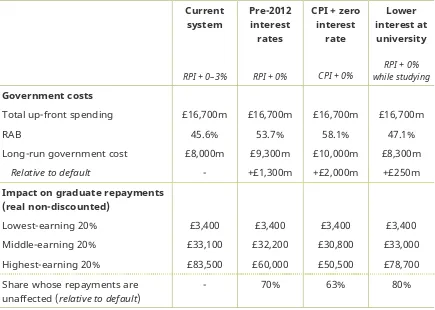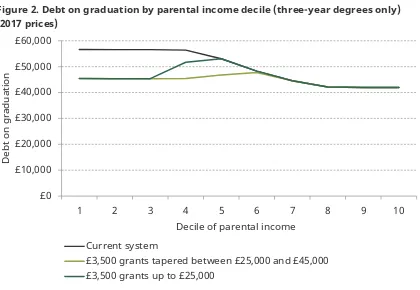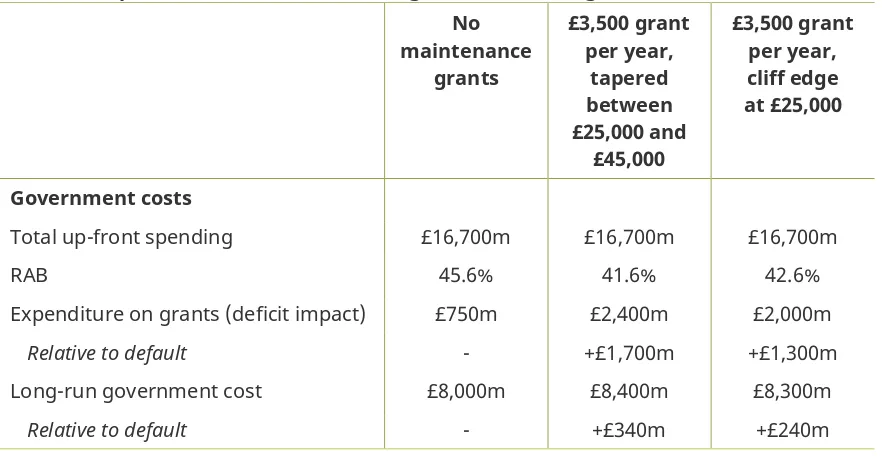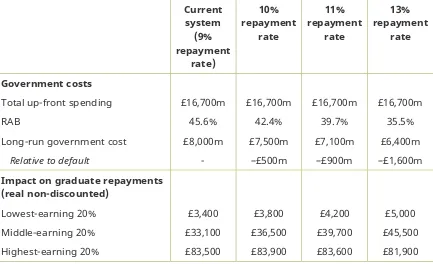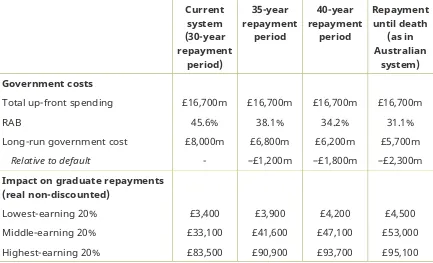Options for reducing the interest rate
on student loans and introducing
maintenance grants
IFS Brie
f
ing
n
ote BN2
21
Options for reducing the interest rate on student loans and
reintroducing maintenance grants
Chris Belfield, Jack Britton and Louis Hodge
Copy-edited by Judith Payne
Published by
The Institute for Fiscal Studies
ISBN 978-1-911102-73-1
The authors would like to thank Paul Johnson for providing extremely useful comments and Laura van der Erve for help with the modelling.
This research was funded by Universities UK. The authors would like to thank the Department for Education for providing the linked NPD–HESA data.
The data creators, depositors, copyright holders and funders bear no responsibility for the analysis, inferences, conclusions or interpretation of the data presented here.
2 © Institute for Fiscal Studies
Executive summary
In October, the Prime Minister called for an inquiry into the student loan system for higher education (HE). In this briefing note, we focus on two of the more unpopular features of the current system. We explore government options for reducing the interest rates charged on student loans, from the current levels of RPI + 3% while studying and RPI + 0– 3% (depending on income) after leaving university, and for reintroducing living-cost grants – which do not have to be repaid – for students from lower-income families. This briefing note will be submitted as evidence for the inquiry.
Key findings
Interest rates
Positive real interest rates on student loans increase the debt levels of all graduates but
only increase the lifetime repayments of higher-earning graduates. Removing them does not affect up-front government spending on HE, but it does slightly increase the deficit (due to the slightly confusing treatment of interest accrued on student debt in the government finances). More significantly, it also increases the long-run costs of HE due to the associated reduction in graduate repayments.
Reducing the interest rates to RPI + 0% for everyone would reduce the debt levels of all
graduates. Debt on graduation would be around £3,000 lower on average, while average debt at age 40 would be £13,000 lower. However, because of the link between income and interest in the current system, this cut would reduce the debts of the highest-earning graduates the most: the richest 20% of graduates would hold around £20,000 less debt at age 40 as a result of this policy, while the lowest-earning 20% of graduates would be just £5,500 better off in terms of debt held at the same age.
This policy of switching to RPI + 0% would have no impact on up-front government
spending on HE, but would cost the taxpayer £1.3 billion per year in the long run. It would be a significant giveaway to high-earning graduates, saving the richest 20% more than £23,000 over their lifetimes.
A less costly policy would be to reduce interest rates to RPI + 0% while studying and
leave rates unchanged after graduation. This would reduce the debt levels of all graduates at age 40 by around £5,000. It would be a significantly cheaper reform, costing around £250 million per year in the long run. Again, there is little impact on the repayments of low- and middle-earning graduates, while the highest-earning graduates would be around £5,000 better off over their lifetimes.
Maintenance grants
Reintroducing maintenance grants in place of loans also has no impact on up-front
© Institute for Fiscal Studies 3
Reintroducing grants of £3,500 under a similar system to that before 2016 would
increase deficit spending by around £1.7 billion, but the long-run cost is only around £350 million. This reform would reduce the debt on graduation of students from low-income backgrounds taking a three-year degree by around £11,000.
The beneficiaries from this change in terms of actual lifetime loan repayments are
4 © Institute for Fiscal Studies
1. Introduction
In October, Prime Minister Theresa May announced a tuition fee freeze and an increase in the threshold above which students begin to make repayments on their student loans.
These reforms will represent a significant giveaway to graduates. Previous IFS work1
estimated they will increase the long-run taxpayer cost of providing higher education (HE)
by £2 billion per year, to the benefit of predominantly low- and middle-earning graduates.2
Despite this, many elements of the system remain deeply unpopular, and the Prime Minister has called for a review of the student loan system and the related financial
implications.3 In this briefing note, we explore the government options for addressing two
unpopular features of the student finance system: reducing the high interest rate charged on student loans and reintroducing living-cost grants for students from low-income families.
1 C. Belfield, J. Britton and L. van der Erve, ‘Higher education finance reform: raising the repayment threshold to
£25,000 and freezing the fee cap at £9,250’, IFS Briefing Note BN217, October 2017, https://www.ifs.org.uk/publications/9964.
2 The thresholds determining the interest rates on student loans also increased in line with the repayment
threshold (to £25,000 and £45,000). This change represents around £200 million of the £2 billion cost (authors’ calculations).
3 The Treasury Select Committee officially launched a new inquiry into the student loan system on 14 October
© Institute for Fiscal Studies 5
2.
Interest rates
Student loans accrue interest both while students are at university and after they have graduated. Under the current system, while students are at university the interest rate is
set at the Retail Prices Index measure of inflation (RPI) plus 3% (currently equal to 6.1%).4
After university, the interest rate depends on income: the interest rate charged for graduates with annual incomes up to £25,000 is equal to RPI and this increases with income to RPI + 3% for those with incomes of £45,000 and above. This contrasts with the pre-2012 system, under which all students and graduates were charged an interest rate equal to RPI.5
The RPI measure of inflation used to index the student loan interest rate is widely discredited and has been shown to systematically overstate inflation compared with the more widely accepted Consumer Prices Index (CPI) measure, by around 1 percentage
point.6 As a result, the real interest rate, relative to the CPI, charged on student loans
varies between around 1% and 4%. This is relatively high compared with market interest
rates. Our previous work7 has shown that the average student taking a three-year degree
accrues around £6,000 of interest while at university (in 2017 prices).
In this section, we investigate the impacts of three potential reforms to the system: aligning with the pre-2012 system and removing the positive rate over RPI, so that all graduates are charged RPI + 0%; moving to using the CPI, so that students and graduates are charged CPI + 0%; and removing the positive rate over RPI while studying, so that students are charged RPI + 0% while studying and RPI + 0–3% after leaving university, depending on income (as is currently the case).
One reason to consider these types of reform is simply that positive interest rates appear to be deeply unpopular, even if they make no difference to the actual repayments of many graduates.
Figures 1a, 1b and 1c show, in 2017 prices, the level of student debt graduates in the top, middle and bottom 20% of earners hold over their lifetime and the impact on this level of changing the interest rate to ‘RPI + 0% for all students and graduates’, ‘CPI + 0% for all students and graduates’ and ‘RPI + 0% while studying’ respectively. Under the current system, the real debt levels of the highest-earning graduates decline as they steadily repay the loan. The debt levels of the lowest-earning graduates increase, however. The repayments made are outweighed by the positive real interest rate charged.
Reducing the interest rate to ‘RPI + 0% for all students and graduates’ reduces the level of debt held by all graduates at all ages. Debt on graduation would be around £3,000 lower on average, while average debt at age 40 would be £13,000 lower. However, it is the highest-earning graduates who benefit the most. At age 40, this reform would reduce the
4 The interest rate for the academic year is based on the rate of RPI in the previous March. 5 The interest accrues daily but this rate is the annual equivalent rate (AER).
6 For estimates of the difference between CPI and RPI measures of inflation, see box 3.3 in Office for Budget
Responsibility, Economic and Fiscal Outlook – March 2015, http://budgetresponsibility.org.uk/efo/economic-fiscal-outlook-march-2015/.
7 C. Belfield, J. Britton, L. Dearden and L. van der Erve, ‘Higher education funding in England: past, present and
6 © Institute for Fiscal Studies
[image:7.595.89.499.182.427.2]average debt level of the lowest-earning graduates by around £5,500 while the highest-earning graduates would have debt levels nearly £20,000 lower. This is largely because the lowest-earning graduates often earn less than £25,000 per year and so face an interest rate of RPI + 0% anyway.
Figure 1a. Impact of interest rates on graduates’ outstanding debt: switch to RPI + 0% for all students and graduates (2017 prices)
Figure 1b. Impact of interest rates on graduates’ outstanding debt: switch to CPI + 0% for all students and graduates – zero real interest (2017 prices)
£0 £10,000 £20,000 £30,000 £40,000 £50,000 £60,000 £70,000 £80,000
21 26 31 36 41 46 51
Rea l va lu e of ou ts ta ndi ng debt
Age of graduates
Current – low earners Current – mid earners Current – high earners
RPI + 0% – low earners RPI + 0% – mid earners RPI + 0% – high earners
£0 £10,000 £20,000 £30,000 £40,000 £50,000 £60,000 £70,000 £80,000
21 26 31 36 41 46 51
Rea l va lu e of ou ts ta ndi ng debt
Age of graduates
Current – low earners Current – mid earners Current – high earners
[image:7.595.90.504.470.725.2][image:8.595.90.506.115.355.2]
© Institute for Fiscal Studies 7
Figure 1c. Impact of interest rates on graduates’ outstanding debt: switch to RPI + 0% while studying (2017 prices)
Source: Authors’ calculations using IFS’s graduate repayments model. Low earners are the graduates with the 20% lowest lifetime earnings, mid earners have lifetime earnings between the 40th and 60th percentiles of the
graduate lifetime earnings distribution and high earners are the graduates with the 20% highest lifetime earnings. See appendix notes for more.
Reducing the interest rate to ‘CPI + 0% for all students and graduates’ has a larger impact, with the highest-earning graduates again benefiting most. At age 40, it would reduce the average debt level of the lowest-earning graduates by around £17,000 and of the highest-earning graduates by around £26,000. Conversely, reducing interest rates to ‘RPI + 0% while studying’ affects the debt levels of all graduates to a similar extent, reducing debt at age 40 by around £5,000.
However, student loans are not like typical loans. Repayments are made as a proportion of earnings and are not directly linked to the size of the loan or the interest charged. Any outstanding loan is written off 30 years after graduation. This effectively means that students only repay the interest accrued on student loans once the principal has been fully repaid. Only 17% of graduates are expected to completely clear their student loans
(principal and interest) before they are written off.8 As a result, changes to the interest
rate only affect the repayments of the very highest-earning graduates.
Table 1 sets out the government cost and graduate repayments under various different interest rate systems. The current system – taking into account the reforms announced in
October – has a long-run cost to government of £8.0 billion per cohort of HE students.9
8 C. Belfield, J. Britton and L. van der Erve, ‘Higher education finance reform: raising the repayment threshold to
£25,000 and freezing the fee cap at £9,250’, IFS Briefing Note BN217, October 2017, https://www.ifs.org.uk/publications/9964.
9 This figure is slightly different from that published in IFS Briefing Note BN217 (see previous footnote) as that
used a representative subsample of graduate earnings projections. Re-estimating using the same method as here leads to small changes.
£0 £10,000 £20,000 £30,000 £40,000 £50,000 £60,000 £70,000 £80,000
21 26 31 36 41 46 51
Rea
l va
lu
e
of
ou
ts
ta
ndi
ng
debt
Age of graduates
Current – low earners Current – mid earners Current – high earners
8 © Institute for Fiscal Studies
This cost is comprised of £750 million of teaching grants10 and 46% of the value of loans
paid out not being repaid. The repayments of graduates vary significantly by their earnings: the lowest-earning 20% of graduates only repay on average £3,500 over their lifetimes whereas the highest-earning 20% of graduates pay more than £80,000 on average.
All of the estimates provided here involve projections of the earnings of all graduates up to 30 years into the future. They are therefore uncertain, being particularly susceptible to both future policy changes and deviations from the expected path of graduate earnings growth. The potential impacts of changes in graduate earnings projections, the
[image:9.595.83.518.281.591.2]government cost of borrowing and the non-take-up of loans are discussed in previous IFS work.11
Table 1. Impact of various interest rate reforms on government cost and graduate repayments
Current system
RPI + 0–3%
Pre-2012 interest rates
RPI + 0%
CPI + zero interest
rate
CPI + 0%
Lower interest at university
RPI + 0% while studying
Government costs
Total up-front spending £16,700m £16,700m £16,700m £16,700m
RAB 45.6% 53.7% 58.1% 47.1%
Long-run government cost £8,000m £9,300m £10,000m £8,300m
Relative to default - +£1,300m +£2,000m +£250m
Impact on graduate repayments (real non-discounted)
Lowest-earning 20% £3,400 £3,400 £3,400 £3,400
Middle-earning 20% £33,100 £32,200 £30,800 £33,000
Highest-earning 20% £83,500 £60,000 £50,500 £78,700
Share whose repayments are unaffected (relative to default)
- 70% 63% 80%
Source: Authors’ calculations using IFS’s graduate repayments model. See appendix notes for more.
Changing the interest rate has no impact on the up-front government expenditure on HE as the same amount is paid out in loans and grants. There is a small impact on the cost as measured by the deficit, however; government accounting rules mean that all interest accrued on student loans in a given year counts as income offsetting public sector net
10 C. Belfield, J. Britton, L. Dearden and L. van der Erve, ‘Higher education funding in England: past, present and
options for the future’, IFS Briefing Note BN211, July 2017, https://www.ifs.org.uk/publications/9334.
11 C. Belfield, J. Britton, L. Dearden and L. van der Erve, ‘Higher education funding in England: past, present and
© Institute for Fiscal Studies 9
borrowing (the deficit).12 Lowering the interest rate on student loans therefore increases
the deficit in the short run, even though not all of this interest will actually be repaid. What is important for long-run government finances is the impact on actual repayments. We estimate that reducing the interest rate to that in place before 2012 (RPI + 0% for all students and graduates) would increase the long-run government cost by £1.3 billion. This reform would be a significant giveaway to the highest-earning graduates, making the richest 20% of graduates more than £23,000 better off over their lifetimes with little impact on the repayments of low- and middle-earning graduates. In fact, 70% of graduates would experience no change in their repayments.
To provide a sense of the scale of the cost of this reform, we estimate that the
government would have to increase the rate at which graduates repay their loans from 9%
to 13% to offset this cost.13 However, the overall impact of a policy change of this nature
would be to harm low- and middle-earning graduates, while benefiting the highest-earning graduates. This is because high-highest-earning graduates will repay anyway, so will be largely unaffected by the higher repayment rate in terms of their overall contributions.
Introducing an interest rate equal to the CPI measure of inflation would be even more costly. It would increase the long-run government cost by £2.0 billion per year and reduce the lifetime repayments of the highest-earning 20% of graduates by £33,000 on average, again with little impact on low- and middle-earning graduates.
Unsurprisingly, the least costly reform would be to reduce the interest rate while studying from RPI + 3% to RPI + 0% and leave the interest rate for graduates unchanged. This would mean that no student or graduate earning less than £25,000 would accrue interest at a rate above RPI. The reform would cost around £250 million per year in the long run. As with all interest rate reforms, the impact is concentrated on the highest-earning graduates, who benefit by around £5,000 over their lifetimes on average.
12 This treatment of interest rates on student debt has been heavily criticised
(https://andrewmcgettigan.org/2017/07/13/fiscal-illuions/) and the OBR has described this treatment as ‘flatter[ing] the fiscal position’ (Office for Budget Responsibility, Fiscal Risks Report – July 2017,
http://budgetresponsibility.org.uk/frr/fiscal-risk-report-july-2017/).
13 The appendix gives more detail on the impact of increasing the repayment rate (Table A2), alongside the
10 © Institute for Fiscal Studies
3.
Maintenance grants
Higher education students in England are not just eligible for support towards their tuition fees – they have also received government support towards their living costs in the form of maintenance loans (available to all students) and, in the past, maintenance grants (available only to those from poorer households). In 2016, maintenance grants were abolished and replaced with additional maintenance loans. The new additional loans were slightly larger than the grants they replaced, meaning students from a low-income
background had slightly more ‘cash-in-pocket’ while at university but also graduate with the highest levels of debt. Replacing maintenance grants with loans reduced the
government cost of HE measured in the deficit by around £2 billion,14 but because some,
indeed most, of these new loans will not be repaid, the long-run saving was significantly lower.
One of the primary arguments against abolishing maintenance grants was the potentially
negative impact on access. Previous research at IFS15 showed that the removal of
maintenance grants in the late 1990s would have reduced participation had no alternative support been provided. But replacing grants with slightly more generous loans has an ambiguous impact on participation. As yet, there has been no research into the impact of
the 2016 reform.16 However, the reform remains unpopular.17 In this section, we outline
various options the government could pursue to reverse the recent change, setting out the short- and long-run costs to government and the impact on graduate repayments.
We explore two potential options for reintroducing maintenance grants of differing levels of generosity. First, we consider grants up to £3,500 for students from households with gross income below £25,000 per year, with a taper between £25,000 and £45,000. This is roughly equivalent to the system that was in place prior to 2016. We also consider a less generous alternative with more tightly targeted grants – £3,500 for those from households
with income below £25,000 and zero for those above (no taper).18 In both scenarios, we
reduce maintenance loan income one-for-one with additional grants, so student cash-in-pocket is unchanged. Appendix Table A1 shows the results for three additional scenarios: a £1,500 grant with a taper from £25,000 to £45,000 and a £1,500 or £3,500 grant with a
taper from £18,370 to £45,000.19
Figure 2 indicates the impact of these changes to maintenance grants on students’ debt at graduation by decile of parental income. Under the current system, students from the lowest-income families graduate with the highest levels of debt: students taking a three-year degree from the poorest 40% of families graduate with debts of around £56,000,
14 J. Britton, C. Crawford and L. Dearden, ‘Analysis of the higher education funding reforms announced in
Summer Budget 2015’, IFS Briefing Note BN174, July 2015, https://www.ifs.org.uk/publications/7904.
15 L. Dearden, E. Fitzsimons and G. Wyness, ‘The impact of tuition fees and support on university participation in
the UK’, IFS Working Paper W11/17, September 2011, https://www.ifs.org.uk/publications/5648.
16 To the authors’ knowledge.
17 Over 130,000 people signed a petition to prevent the reform, forcing it to be debated in the House of
Commons (https://petition.parliament.uk/archived/petitions/109649).
18 We note that such a policy results in a cliff edge, which may have significant consequences for the behaviour
of parents to manipulate their taxable income in order to avoid large losses in grant income, although there is no immediate impact on the cash-in-pockets of their children as the additional maintenance loans would still be available for this group.
[image:12.595.89.509.74.364.2]
© Institute for Fiscal Studies 11
Figure 2. Debt on graduation by parental income decile (three-year degrees only) (2017 prices)
Source: Authors’ calculations using IFS’s graduate repayments model. See appendix notes for more.
compared with debts of £42,000 for students from the richest 30% of families.
Reintroducing maintenance grants of £3,500 per year would reduce the debt levels of the students from the poorest families by £11,000.
In terms of government finances, reintroducing maintenance grants in this way has no impact on the up-front level of government spending on HE as the grant expenditure merely replaces outgoings on loans. However, because grant spending counts towards the deficit whereas student loans do not, each of these reforms does increase the cost of HE as measured by the deficit. As shown in Table 2, reintroducing full maintenance grants of £3,500 with a taper between £25,000 and £45,000 would increase the impact of
spending on the deficit by around £1.7 billion. The long-run cost, however, is significantly lower, at around £350 million, as a significant proportion of the loans would not have been repaid anyway.
The same level of maximum grant but with no taper is cheaper in both the short and long run: it reduces the deficit cost to £1.3 billion and the long-run cost to around £250 million (relative to having no maintenance grants).
Figure 3 shows the reduction in lifetime repayments resulting from reintroducing maintenance grants, for those who are eligible for full grants and by decile of graduate earnings. Similar to reducing the interest rate, reintroducing maintenance grants serves to reduce only the repayments of the highest-earning graduates. Although the grants are targeted at students from low-income backgrounds, who typically have lower earnings
£0 £10,000 £20,000 £30,000 £40,000 £50,000 £60,000
1 2 3 4 5 6 7 8 9 10
D
ebt
on
gr
adu
ati
on
Decile of parental income Current system
[image:13.595.80.521.89.318.2]
12 © Institute for Fiscal Studies
Table 2. Impact of various maintenance grant reforms on government cost No maintenance grants £3,500 grant per year, tapered between £25,000 and £45,000 £3,500 grant per year, cliff edge at £25,000 Government costs
Total up-front spending £16,700m £16,700m £16,700m
RAB 45.6% 41.6% 42.6%
Expenditure on grants (deficit impact) £750m £2,400m £2,000m
Relative to default - +£1,700m +£1,300m
Long-run government cost £8,000m £8,400m £8,300m
Relative to default - +£340m +£240m
Source: Authors’ calculations using IFS’s graduate repayments model. See appendix notes for more.
Figure 3. Impact of reintroducing grants on lifetime repayments of those who would receive the full maintenance grant, by decile of graduate earnings
Source: Authors’ calculations using IFS’s graduate repayments model. Deciles of earnings are based on the entire graduate earnings distribution. See appendix notes for more.
than students from high-income backgrounds,20 only those students who go on to have
high earnings would have actually repaid the additional maintenance loan they received. There is no impact on the repayments of the lowest-earning 60% of graduates, while students who are eligible for grants and have earnings in the top 10% of graduates would be around £22,000 better off over their lifetimes.
20 J. Britton, L. Dearden, N. Shephard and A. Vignoles, ‘How English domiciled graduate earnings vary with
gender, institution attended, subject and socio-economic background’, IFS Working Paper W16/06, April 2016, https://www.ifs.org.uk/publications/8233. £0 £5,000 £10,000 £15,000 £20,000 £25,000
1 2 3 4 5 6 7 8 9 10
Reducti on in li fetime repa ym ents fr om rein tro du ci ng m ai ntena nce gr an ts
[image:13.595.87.514.374.567.2]
© Institute for Fiscal Studies 13
4.
Summary
This briefing note has assessed the impact of a set of potential reforms to interest rates applied to student debt and the nature of the maintenance support available to students while they are studying. None of the policy options discussed in this briefing note
increases the up-front government expenditure on higher education, but they would increase the government cost of providing HE in the long run in the form of lower graduate repayments.
Reducing the interest rate on student loans to RPI + 0% increases the long-run
government cost by £1.3 billion. This is a smaller increase than the recent change to the repayment threshold, which cost £2.3 billion. It is also a much less progressive reform, as it is the highest earners who benefit the most in this case, while the benefits of increasing the repayment threshold were concentrated further down the distribution. A cheaper alternative interest rate change would be to reduce the interest rate during study to RPI + 0%. This would cost £250 million a year in the long run.
Due to the differential treatment of grants and loans in the public finances, reintroducing maintenance grants would significantly increase the cost of HE as measured by the current deficit, but would increase the long-run cost much less. Reintroducing
maintenance grants at a similar level to that before 2016 would add around £1.7 million to the deficit; however, the long-run cost is only around £350 million.
14 © Institute for Fiscal Studies
[image:15.595.83.518.125.367.2]Appendix
Table A1. Impact of various maintenance grant reforms on government cost No maintenance grants £1,500 grant per year, tapered between £25,000 and £45,000 £1,500 grant per year, tapered between £18,370 and £45,000 £3,500 grant per year, tapered between £18,370 and £45,000 Government costs
Total up-front spending £16,700m £16,700m £16,700m £16,700m
RAB 45.6% 43.9% 44.0% 41.8%
Expenditure on grants
(deficit impact) £750m £1,500m £1,400m £2,300m
Relative to default - +£730m +£670m +£1,600m
Long-run government cost £8,000m £8,200m £8,200m £8,300m
Relative to default - +£130m +£120m +£300m
Source: Authors’ calculations using IFS’s graduate repayments model. See notes below for more.
Table A2. Impact of repayment rate on government cost and graduate repayments Current system (9% repayment rate) 10% repayment rate 11% repayment rate 13% repayment rate Government costs
Total up-front spending £16,700m £16,700m £16,700m £16,700m
RAB 45.6% 42.4% 39.7% 35.5%
Long-run government cost £8,000m £7,500m £7,100m £6,400m
Relative to default - –£500m –£900m –£1,600m
Impact on graduate repayments (real non-discounted)
Lowest-earning 20% £3,400 £3,800 £4,200 £5,000
Middle-earning 20% £33,100 £36,500 £39,700 £45,500
Highest-earning 20% £83,500 £83,900 £83,600 £81,900
[image:15.595.84.517.410.674.2][image:16.595.83.516.91.354.2]
© Institute for Fiscal Studies 15
Table A3. Impact of repayment period on government cost and graduate repayments Current
system (30-year repayment
period)
35-year repayment
period
40-year repayment
period
Repayment until death
(as in Australian
system) Government costs
Total up-front spending £16,700m £16,700m £16,700m £16,700m
RAB 45.6% 38.1% 34.2% 31.1%
Long-run government cost £8,000m £6,800m £6,200m £5,700m
Relative to default - –£1,200m –£1,800m –£2,300m
Impact on graduate repayments (real non-discounted)
Lowest-earning 20% £3,400 £3,900 £4,200 £4,500
Middle-earning 20% £33,100 £41,600 £47,100 £53,000
Highest-earning 20% £83,500 £90,900 £93,700 £95,100
16 © Institute for Fiscal Studies
